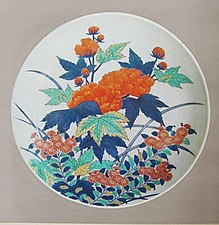Overglaze decoration

Overglaze decoration, overglaze enamelling or on-glaze decoration is a method of decorating pottery, most often porcelain, where the coloured decoration is applied after it has been glazed. It is often described as producing "enamelled" decoration. When the ware is fired, or re-fired in the case of twice-fired ware, the colours fuse into the glaze and so the decoration becomes durable. Because the decorating fire can be at a lower temperature with overglaze decoration, a more varied palette of colours is available than with underglaze decoration, where the coloured pattern is applied before glazing.
The technique was first seen in Chinese ceramics in Cizhou stoneware from as early as the 12th century, with use on porcelain following within a century, though it did not become predominant until later, and the full possibilies were not realized until the 17th century.[1] Some techniques use thin metal leaf as well as the more usual pigments, which are typically applied in a liquid or paste form, painted by brush, or using stencils or transfer printing.
See also
- In-glaze decoration
- Underglaze decoration
Notes
- ^ Vainker, 117, 180-182
References
- Vainker, S.J., Chinese Pottery and Porcelain, 1991, British Museum Press, 9780714114705
